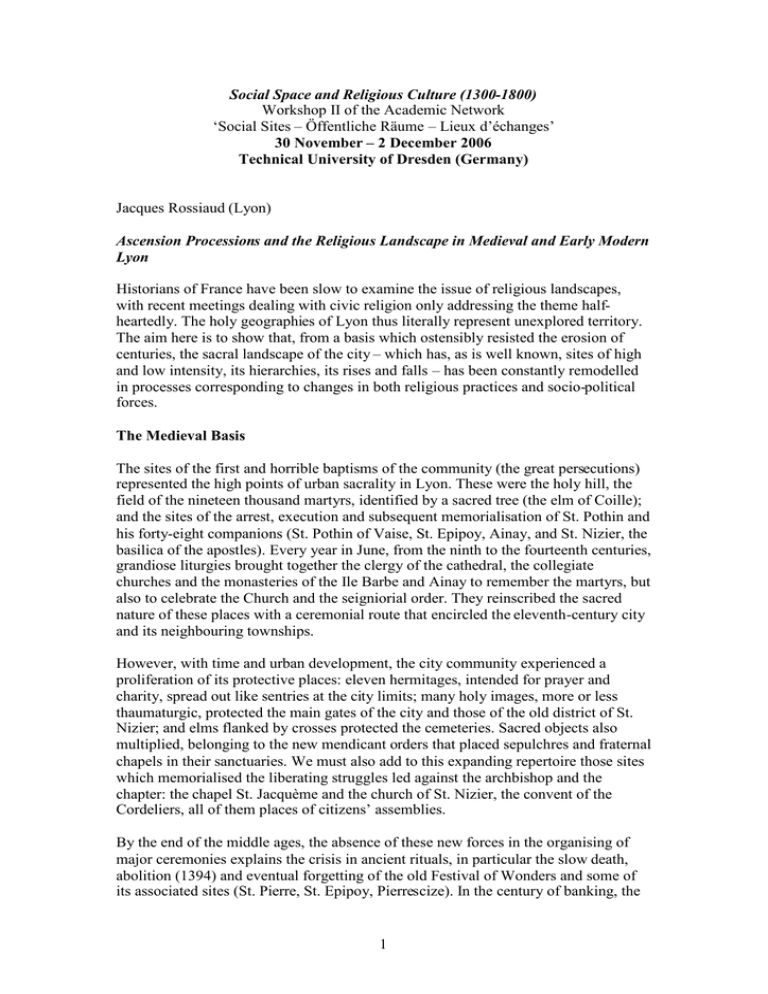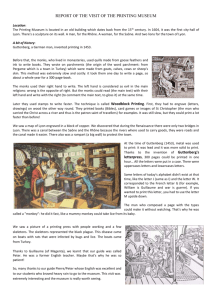Workshop II of the Academic Network Jacques Rossiaud (Lyon)
advertisement

Social Space and Religious Culture (1300-1800) Workshop II of the Academic Network ‘Social Sites – Öffentliche Räume – Lieux d’échanges’ 30 November – 2 December 2006 Technical University of Dresden (Germany) Jacques Rossiaud (Lyon) Ascension Processions and the Religious Landscape in Medieval and Early Modern Lyon Historians of France have been slow to examine the issue of religious landscapes, with recent meetings dealing with civic religion only addressing the theme halfheartedly. The holy geographies of Lyon thus literally represent unexplored territory. The aim here is to show that, from a basis which ostensibly resisted the erosion of centuries, the sacral landscape of the city – which has, as is well known, sites of high and low intensity, its hierarchies, its rises and falls – has been constantly remodelled in processes corresponding to changes in both religious practices and socio-political forces. The Medieval Basis The sites of the first and horrible baptisms of the community (the great persecutions) represented the high points of urban sacrality in Lyon. These were the holy hill, the field of the nineteen thousand martyrs, identified by a sacred tree (the elm of Coille); and the sites of the arrest, execution and subsequent memorialisation of St. Pothin and his forty-eight companions (St. Pothin of Vaise, St. Epipoy, Ainay, and St. Nizier, the basilica of the apostles). Every year in June, from the ninth to the fourteenth centuries, grandiose liturgies brought together the clergy of the cathedral, the collegiate churches and the monasteries of the Ile Barbe and Ainay to remember the martyrs, but also to celebrate the Church and the seigniorial order. They reinscribed the sacred nature of these places with a ceremonial route that encircled the eleventh-century city and its neighbouring townships. However, with time and urban development, the city community experienced a proliferation of its protective places: eleven hermitages, intended for prayer and charity, spread out like sentries at the city limits; many holy images, more or less thaumaturgic, protected the main gates of the city and those of the old district of St. Nizier; and elms flanked by crosses protected the cemeteries. Sacred objects also multiplied, belonging to the new mendicant orders that placed sepulchres and fraternal chapels in their sanctuaries. We must also add to this expanding repertoire those sites which memorialised the liberating struggles led against the archbishop and the chapter: the chapel St. Jacquème and the church of St. Nizier, the convent of the Cordeliers, all of them places of citizens’ assemblies. By the end of the middle ages, the absence of these new forces in the organising of major ceremonies explains the crisis in ancient rituals, in particular the slow death, abolition (1394) and eventual forgetting of the old Festival of Wonders and some of its associated sites (St. Pierre, St. Epipoy, Pierrescize). In the century of banking, the 1 fairs and the triumph of print, the city council adapted the sacral landscape to the city’s new ambitions. Senza (1460-1561) A major new festival appeared towards 1530 after about sixty years of development. The Ile Barbe was the destination of the procession, a good league by the Saône from the city centre. Its monastery, formerly powerful, was rich in treasure and relics, possessing the remains of St. Anne and a gold icon of Our Lady, doubtless miraculously discovered and which, in the thirteenth and fourteenth centuries, had its powers miraculously acknowledged. The ordinary processions and those for the warding off of natural disasters advanced towards her, as the Virgin commanded the elements (especially the waters) when implored in her holy place, her shrine. Not far from her, belonging to a quite different universe, was a profane relic: the horn of the paladin Roland. The day after Rogation (which had sensitised the waters) on Ascension Day, royal officials and consuls, guardians of the gates and clerks of justice, the brotherhoods of printers and river boatmen of St. Vincent, escorted by thousands of citizens, set out in three great boats from the palace at Roanne and sailed up the Saône. Once in front of the island (on the frontier of Savoy), the king’s officers in connivance with those of the duke performed a ritual challenge and acknowledgement of the boundaries, listened to warlike poetry, and revered Our Lady of the Island before sailing back down the Saône, in triumph. For the population of Lyon, these festive rituals obliterated certain internal frontiers (dating from the city’s origins), settled a territorial problem which could be dramatised because it was no longer very important, and reconciled on a symbolic level two legal realities (sovereignty and feudal lordship) which confronted each other on the water. Finally, they recalled through epic and Rolandian exaltation that Lyon remained a frontier city to the nearby Comté. The ritual was intended above all to show within a symbolic space (Lyon – Ile Barbe = Saône – Rhône) that Lyonnais people could navigate safely along a waterway protected by royal officials, and on water whose calm was assured by a mediating Virgin, duly honoured. This fine example of the appropriation of the sacred by the protectors and fathers of the city took place, let us note, on the fringe of the ecclesiastical framework, in a place – the ‘insula’ – sometimes identified with the Gallic Island, the germ of the city of Lyon, a place outside the barony of the Church as the haven of a Virgin who showed herself to be more powerful than the one whom the canon-counts had wanted to be worshipped at Fourvière. The end of the citizens’ pious journey thus proudly ignored the natural seigniorial order, too nostalgic for its former power. The Reorientation of the Classical Age The triumphal Ascension represented a concentration of all the evils denounced by the reformers and, to a lesser extent, by the Tridentine Church: the pollution of the sacred by profane practices; the acceptance of dubious sacral qualities; independence of ecclesiastical control; and the confusion of politics and religion. 2 Already, in a period of wealth, some worshippers had denounced sites of ‘popular superstition’, even in the very cloister of St. Jean, whilst those who demanded urban scene paintings had the portrayal of sacred elms replaced by crosses. After 1561, the clergy asserted their monopoly over all things sacred with greater effectiveness by condemning exuberances, riotous processions, and by uprooting from their territory evil weeds from evil places. Wars and impoverishment aided the cause. The triumphal Ascension disappeared, and with it the happy Pentecosts and pious feasting around the elms. Henceforth, the people of Lyon went as penitents to worship Our Lady of Fourvière. However, not all Catholics shared the gloomy and hierarchical sensibilities of the new, official mode of worship. Claude de Rubys and Louis Garon were among those who attributed the disappearance of the festivals simply to the poverty of the period. They deplored this barrenness and compensated for it by evoking the lost marvels, which they took delight in exaggerating, whilst always complying with the order desired by the new clergy. Among the reinvented festival of marvels, one striking example pitted young patricians against raging bulls (Blandine’s posthumous revenge) at the foot of the Saône bridge; another comprised a belligerent but ritualised encounter between the children of Lyon and Vienne, but under the pious gaze of clergy from both cities. Claude de Rubys institutionalised the bonfires of the Festival of St. Jean, which he set on the Saône bridge, while Louis Garon turned the Fête of the Mad Horse into a commemoration of the victory of order over senseless rebels. For the most part, these inventions have retained their place in the collective ‘Lyonnais memory’ for several centuries, whilst ritual realities, as we have seen, were constantly transformed. Let us be cautious when we write… 3





